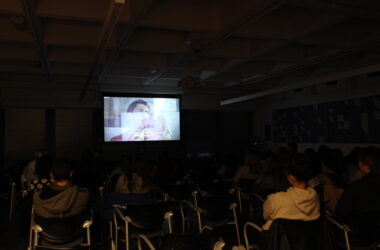 magpictures.com
magpictures.comThe apocalypse has never looked so beautiful. Melancholia, the latest from maverick Danish auteur Lars von Trier, is magnificent. With a script that joins human introspection with nihilistic celebration, von Trier creates two hours of rich, thought-provoking and breathtaking cinema. Its long journey from Cannes to Canada now complete, Melancholia is assuredly one of the year’s most compelling films.
Like Antichrist before it, Melancholia begins with a devastatingly powerful series of near-stills, this time set to a Wagner score. A bride runs, grey gooey tendrils clinging to her legs. A woman carries a child through a golf course that’s turned into quicksand. Electricity rises from fingertips like ethereal vapours. Finally, in a moment of horrifying beauty, Earth collides with the mystery planet Melancholia and is destroyed. Obliterated. Gone.
The real plot of the movie begins with a wedding party. Newlyweds Justine (Kirsten Dunst) and Michael (Alexander Skarsgård) arrive late for a dinner, planned by Justine’s sister, Claire (Charlotte Gainsbourg). Cracks can almost immediately be seen in the lavish, decadent get-together. Justine and Claire’s father (John Hurt) only flirts and drinks. Their mother (Charlotte Rampling) publicly denounces the institution of marriage in her wedding toast. Justine’s boss, Jack (StellanSkarsgård) only sees her as a means to his own profit-seeking end. Claire’s husband, John (Kiefer Sutherland) foots the extravagant bill and refuses to let others forget the fact. Alone within this maelstrom is Justine, who, on what should be the happiest day of her life, is anything but pleased. As viewers watch, intrigued and horrified, she begins to disassemble her life, peeling away at superfluous layers until all that is left is a cold, calculating core.
Although some may approach Dunst with suspicion, rest assured that the Best Actress nomination she picked up at Cannes was well-deserved; Justine is a role that demanded formidable dimensions, and Dunst gave what was arguably the best performance of her career to date. The rest of the cast was commendable too, to von Trier’s credit. From the younger Skarsgård’s thousand-yard stare to Sutherland’s surprisingly subtle characterization, performances across the board were brilliant. They were aided by von Trier’s signature hand-held cinematography, flawless here, and the edits, of the wedding scenes in particular, were impeccable. The Dane also wrote the script, littering it with both provoking dialogue and intellectual subtleties. Is that Salome bearing the head of John the Baptist? Is this landscape a loose reference to the film Last Year at Marienbad?
In the second half, Melancholia’s ascension in the sky is paralleled by Justine’s resurrection as an icy, rationalist angel of death. The thematic crux of the film lies with the role of the naive and fearful passing on to Gainsbourg’s Claire. A wonderful dynamic is developed: the audience knows the eventual fate of the Earth, and the suspense is derived not from the cataclysm itself, but the actions and states of the characters leading up to it. When the moment does come, there are no Roland Emmerich-style CGI crane-shots of destruction and devastation. Instead, the scene is exactly as the apocalypse should be: harmonious, blood-pumping, sublime, and followed by a silence that stretches to eternity.
With Melancholia, von Trier exhibits that rare, glorious marriage of brains and beauty. The result is art that is breathtaking in its splendour and simultaneously troubling and relieving in its implications. Its title may be a singular emotion, but watching Melancholia will yield infinitely more.







